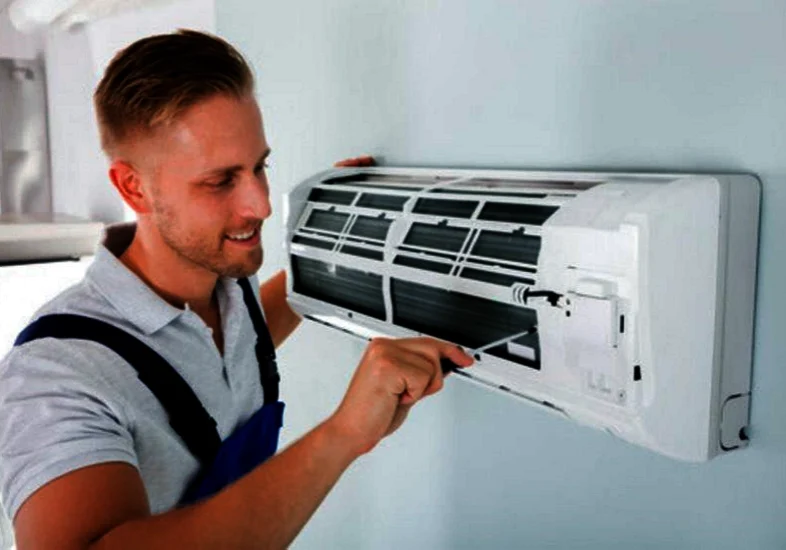Expert Tips for Ductless Mini-Split Maintenance

Maintaining your ductless mini-split system doesn’t have to be a daunting task.Regular upkeep is not just about saving money;it’s about ensuring that your home stays comfortable throughout the year,no matter how extreme the weather gets.Just like in any DIY project,understanding the crucial steps can help you keep your mini-split running efficiently without costly repairs.
One key aspect often overlooked is cleaning and replacing filters.These components are vital to both air quality and efficient operation,yet many let them gather dust until problems arise.Knowing when and how to clean or replace these filters can make all the difference in extending the life of your system while maintaining optimal performance.
To effectively maintain your ductless mini-split system,regularly clean or replace air filters every one to three months,and ensure there is at least a four-foot clearance around the outdoor unit for proper airflow.Additionally,it is crucial to schedule professional maintenance checks annually in spring and fall to address any issues like refrigerant leaks and coil cleaning,thereby extending the system’s lifespan and improving its efficiency.
Cleaning and Replacing Filters
The filters in your ductless mini-split system are much more than just screens;they are vital components that help maintain the air you breathe and the efficiency of the system itself. see details Neglecting these filters can lead to a decline in indoor air quality and added strain on your unit,which could shorten its lifespan.Thus,regular maintenance should be a priority for every homeowner.
Step-by-Step Guide to Cleaning Filters
To ensure you’re getting the best performance from your system,here’s an easy-to-follow guide:
First,always turn off the unit before starting any cleaning task.This is not only for your safety but also prevents dust from being blown around while you work.Picture this:you’re all set to clean,and as soon as you open the panel,clouds of dust erupt into the air—definitely not ideal.
Next,carefully proceed to remove the front panel.Most models have straightforward mechanisms such as latches or screws.Just take your time with this step so as not to damage anything;it’s like opening a fragile box to find hidden treasures inside.
Once the panel is open,you’ll need to extract the filters.Gently pull them out with both hands—after all,they could be a bit dusty!Inspect them closely;if you spot any significant damage or accumulation of dirt that appears resistant to removal,it might be time for a replacement.
Now comes the satisfying part see details :vacuum and wash.Use a handheld vacuum to remove loose dust.Think of it as giving your filters a little spa treatment!After vacuuming,wash them under lukewarm water using mild detergent.Hot water can actually warp the material,which is something we want to avoid,so make sure you stick with a lukewarm temperature.Give them a good wash but also remember to ensure they dry completely before putting them back in—nobody wants moisture lurking in those corners.
Lastly,once everything is dry,it’s time to reinstall your clean filters by sliding them back into place securely.Close up the front panel gently and turn your unit back on.You’ve just improved both air quality and system efficiency!
Regularly checking your ductless mini-split system’s filters shouldn’t feel like a chore—it should feel empowering,knowing you’re taking steps towards maintaining a healthier indoor environment.
For optimal performance,aim for cleaning those filters every month if you’re using the unit frequently;otherwise,every one to three months should suffice in normal situations.Remember,small steps lead to big improvements!
Maintaining Condenser and Evaporator Coils
The coils in your ductless mini-split system serve a critical role in the heat exchange process—specifically,they absorb and expel heat.However,over time,these coils can collect dirt,debris,and grime that dramatically affects the system’s efficiency.A clean coil operates effectively,while dirty coils can cause your unit to work overtime,leading to increased energy costs and a shortened lifespan.
Before starting the cleaning process,it’s vital first to ensure safety.This involves turning off the power to the unit completely.You don’t want to find yourself in a hazardous situation while working on electrical components.After that,you’ll need to access the coils by removing the front panel from the indoor unit and the cover from the outdoor unit learn more .Each model varies slightly,so consult the manufacturer’s manual if you’re unsure about how to proceed.
Next comes selecting the proper cleaning solution.It’s advisable to use a coil cleaner specifically designed for HVAC systems,as these cleaners are formulated to be effective without damaging sensitive components.Foaming aerosol coil cleaners are commonly available at most hardware stores.After applying the cleaner generously over all areas of the coil—ensuring thorough coverage but avoiding oversaturation—you’ll want to let it sit for about 10-15 minutes.This waiting period allows the cleaner to penetrate and break down any built-up grime effectively.
After allowing the cleaner ample time to do its job,rinsing is just as vital as applying the solution itself.For the outdoor unit,you can gently rinse off the coils with a hose.The indoor unit requires a more measured approach;a spray bottle would be adequate here since you want to control the amount of water introduced during rinsing.
Once rinsed,allow some time for drying before reassembling all components.Moisture on electrical connections can lead to corrosion or short circuits in heating and cooling systems.Ensuring that everything is dry guarantees a smooth operational restart when you power it back up.
Taking these steps promotes efficient operation and prolongs your system’s life.
Ensuring Proper Refrigerant Levels
Maintaining proper refrigerant levels in your ductless mini-split system is a task that shouldn’t be overlooked.Think of refrigerant as the lifeblood of your cooling and heating system.It facilitates the transfer of heat,rapidly cycling between gas and liquid states to move warmth away from inside your home during the summer or bring it in during colder months.
When refrigerant levels dip too low,you’re essentially running your system on fumes.This can lead not just to poor temperature control but also to significant damage to the compressor,which can be a costly fix.
HVAC experts strongly advocate for an annual check-up on refrigerant levels as part of routine maintenance.During this inspection,a technician will assess whether the refrigerant charge—measured in pounds for systems like yours—is within the manufacturer-recommended range.
Ideally,monitoring these levels helps prevent inefficiency down the line.When refrigerant is low,you may find that your unit struggles to cool or heat effectively.Not only does this decrease comfort in your home,but it can also lead to higher energy bills as your system works overtime to compensate for the lack of cooling or heating capacity.
Always consult a professional HVAC technician for checking and maintaining these levels.Handling refrigerants requires expertise due to their classification under EPA regulations;unauthorized management can lead to environmental hazards and legal implications.Professionals are equipped with the knowledge and tools necessary not only to fix issues related to refrigerants safely but also to measure pressure accurately and recharge systems efficiently when needed.
By ensuring that your mini-split’s refrigerant levels remain within optimal ranges,you will unlock enhanced performance and efficiency while prolonging your system’s life.Following through with this critical maintenance will further support a seamless transition into effectively managing other essential components,such as keeping exterior units clear.
Keeping the Exterior Unit Clear
An outdoor unit is like the lungs of your ductless mini-split system;it requires fresh air for optimal functioning.When vegetation,debris,or snow hinders airflow,your system can face overheating and decreased performance explore now .Therefore,it’s crucial to maintain a clear perimeter around the unit.
Another common issue is debris accumulation.Leaves,grass clippings,and other remnants can clog the base of the unit,reducing its efficiency.I recommend making it a habit to check the area bi-weekly during active seasons like spring and summer when debris tends to gather more quickly.Imagine you’re taking care of a garden—orders must be kept,and regular maintenance is key.If you find that your outdoor area is prone to heavy leaf fall or other forms of clutter,consider setting up a simple cleaning schedule.
Snow and ice can pose their own set of challenges in colder climates.After all,chilly weather might leave a thick layer around your outdoor unit if not monitored closely.In winter months,ensure snow is removed promptly to prevent ice formations that block airflow and impact efficiency.A protective cover can safeguard against heavy snowfalls;however,be cautious not to restrict airflow with tight-fitting covers.
Clear surroundings nurture efficient operations while safeguarding your investment.By regularly inspecting the area around your mini-split unit and taking proactive steps against potential obstructions,you can sustain both its functionality and longevity with little effort over time.
Draining and Checking for Leaks
Proper drainage is essential for your ductless mini-split system,as it prevents water damage and helps maintain efficiency.A well-functioning drainage system allows condensation to exit without issue,but leaks or blockages could lead to problems that require immediate attention.It’s like a delicate balance;one small issue can upset the overall performance of your system.
Checking and Maintaining the Drain Line
The first step in ensuring proper drainage involves locating the drain line of the indoor unit.Typically,this line runs from the unit to an area where it can safely release water outside.Once you’ve identified this line,it’s time to inspect it thoroughly.
Begin by checking for any visible blockages or obstructions.Debris can accumulate over time,leading to clogs that prevent proper drainage.If you notice anything amiss,don’t fret!A wet/dry vacuum can be a handy tool here.By using it to clear the line,you’ll help restore free flow and avert potential water damage inside your home.
After ensuring there are no physical barriers in the drain line,consider flushing it with a small amount of white vinegar.This action helps kill mold or algae that may have started to grow and works as a preventive measure against buildup.Performing this simple task about every few months can significantly benefit optimal system performance.
While inspecting your system,keep an eye out for any signs of water dripping inside your home.This often indicates a clogged or disconnected drain line requiring immediate attention.However,if you notice any unusual signs like refrigerant leaking—often characterized by frost on pipes or hissing sounds—it’s imperative to contact a professional technician right away.
Regular professional inspections don’t just address immediate concerns—they also help ensure long-term efficiency and reliability.By investing in these checks,you’re safeguarding your investment while promoting energy savings and consistent comfort in your home.Don’t hesitate to reach out to us at Diamond Comfort or call us at (413) 527-4737 to schedule a maintenance check with our certified technicians.They’ll handle the technical aspects with expertise,so you can breathe easier knowing your system is in good hands.
Have Any Questions?
Get in contact with us today! We are always happy to help, and you can count on our expertise.

